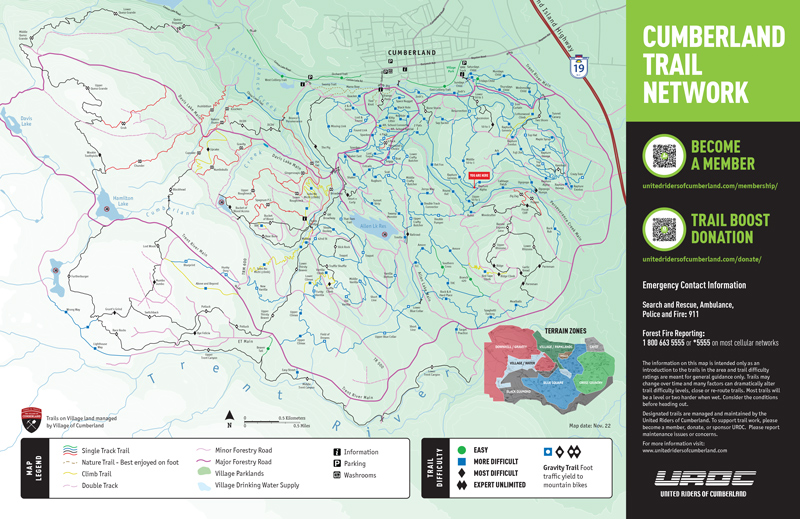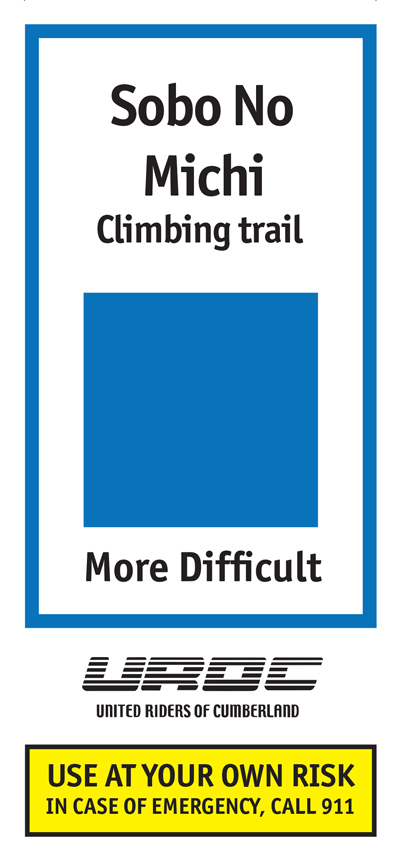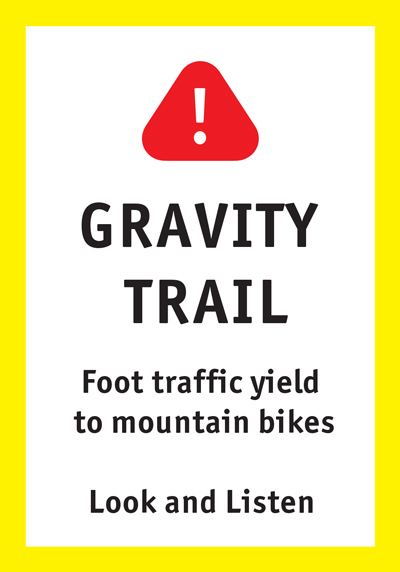The United Riders of Cumberland holds the land access agreement with the landowners, Mosaic Forest Management, Manulife Investment Management and the Village of Cumberland, and is responsible for managing, maintaining and developing trails in the trail network.
To ensure safe, enjoyable, and cohesive trail use for everyone, familiarize yourself with the rules and regulations, code of conduct, and trail etiquette guidelines below.
Trail Etiquette
- Respect other trail users
- Be kind to one other
- Say Hi, acknowledge, smile or wave
- Pass by with discretion and give each other space
- When passing tell people how many are in your group (and dogs)
- Always look up when ascending trails, and be aware of folks descending. (See Gravity trails designation)
- Refrain from using earbuds or headphones, keep your senses about you
- Refrain from stopping or congregating on the trails and refrain from gathering at trail starting points and trail endings
- Enjoy the trails and have the best day
Code of Conduct
- Stay on marked trails and designated trails, and don’t trespass on adjacent property
- Obey all signs and trail closures. Closed means closed
- Respect the land, landowners, wildlife, and habitat, and leave no trace
- Be responsible: these trails are unsupervised and are to be used at your own risk
- Water sources are not drinkable. Please bring your own water
- Don’t litter, pack out what you pack in
- Don’t leave trail trinkets, memorials, or unauthorized signage
- Stay on the trail tread and don’t braid the trails. Ride, run, or walk-through / over puddles and don’t go around thus braiding the trail
- Avoid trail use during atmospheric rivers and freeze-thaw cycles
Rules and Regulations
- No motorized vehicles
- No camping or overnight stays
- No fires
- No unauthorized trail building or unauthorized trail work
- No swimming in lakes
- No dogs in lakes No horses on single track
- Pets must always be under control. Please clean up after your pet
Trail Definitions

Multi-use Trail Network: a trail network that provides opportunities for bikers, runners, walkers, and hikers and strives to be inclusive to meet the needs of diverse ages and abilities of all users.

Multi-use Trail: a non-exclusive use trail that is shared by mountain bikers, hikers, and runners. All users share the responsibility to make each pass a safe and courteous one. All users share the responsibility to ensure they can yield safely and with the least impact on the surrounding environment. Who yields is not exclusive to one user group or direction of travel.

Gravity Trail: a non-exclusive trail where design attributes such as grading, alignment, and presence of technical trail feature impact user speed and response times for interactions with others on the trail. Foot traffic should yield to mountain bike traffic for safety reasons. Typically a Gravity trail will be attributed with fast, steep, or technically challenging trails and is not exclusive to any one trail designation.

When viewing the trail maps, these symbols denote a gravity trail. On these trails foot traffic yields to mountain bikes.
Trail Difficulty Designations

Green Circle
Gentle Climbs and easily avoided obstacles such as roots, rocks, and potholes.

Blue Square
Challenging terrain with steep slopes and/or obstacles, possibly on a narrow trail with poor traction. Requires a level of experience.

Black Diamond
A mixture of long steep climbs or descents, loose trail surfaces, numerous difficult obstacles to avoid or jump over, drop-offs, and fast corners.

Expert Unlimited / Double Black
Exceptional control skills and balance are essential to clear many challenging obstacles or very steep terrain. High-risk level.
Passing Practice & Communication
- Let others know when you want to pass them and make sure you communicate clearly.
- Listen for other riders behind you and find a safe place to pull over and let them pass.
- When passing from behind say “passing on the left or right” and thank you
- If you are passing as a group on the trail, you can let them know what to expect… “Three more behind me”, “I’m last”, etc. help other users know when it’s safe to hit the trail again. You may also want to mention “Thank you, and have a good day”
- On any climb trails, the trail user behind should yield to the user in front; if you are significantly faster than them, only pass when it is safe to do so or on invitation from the forward user. Find a pullout, or where there is an easier section for both users to make a safe pass.
E-bikes
- E-bikes yield to non-e-bikes. On a two-way trail, regardless of direction, e-bikes should yield to non-e-bikes. While on climb trails, e-bikes should yield to non-e-bikes and exercise the same passing and communication practices as all other users. E-bikes do not get right of way because they are faster at climbing.
- E-bikes that are permitted for use in the Cumberland trail network are pedal-assist Class 1 e-bikes only. Class 2 and 3 e-bikes which are throttled-powered or e-unicycle throttled-powered or gas-powered forms of transport are not permitted for use on the Cumberland trails for recreation.
- Adaptive E-bikes are permitted and we ask users to avoid skidding and wheel spinning where practically possible.
Trail users be in control
- Always know your limits and enjoy the trails within your own boundaries and skill level.
- All Cumberland trails are used by multiple trail users, always be considerate to other trail users and strive for a positive experience.
- Can you stop or yield safely?
- Always be prepared for someone around a blind or hidden corner.
- Understand trail definitions and designations.
- Always scoping out technical trail features before you ride is recommended. When checking features, make sure you’re not standing in a blind spot, and that your bike is well off the trail.
- Ride, don’t slide, roost or skid. Try to avoid these activities, especially on wet and loose dirt.
- Strava times do not take precedence over trail user safety and good conduct.
Bear tips and recommendations
- If you’re on your own it’s a good idea to talk or sing to avoid surprising a bear.
- Be extra cautious around running water, trails that are in thick brush, or when high winds prevail as these factors may mask your presence.
- Bear bells are not recommended (BC adventure smart) as the high-pitched tinkle does not travel as far and is not recognized as a human. Bear bells may be a good consideration for your dog as the bell will keep you aware of your dog’s presence at any given time.
Always be aware of your surroundings and headphones are not recommended when biking, hiking, or running in bear country (BC adventure smart). - Recreating with another person results in more noise and may also help dissuade a bear from taking interest in you.
- It is recommended to keep pets leashed or under control.
- Carry bear spray and know how to use it.
Cougar tips and recommendations
- Be always alert and aware.
- Avoid surprise encounters by making noise.
- Hike or bike in groups of two or more and keep children close at hand.
- Bear bells are not recommended (BC adventure smart) as the high-pitched tinkle does not travel as far and is not recognized as a human. Bear bells may be a good consideration for your dog as the bell will keep you aware of your dog’s presence at any given time.
- Look for signs of fresh cougar activity – i.e. claw marks on trees or logs, scat, or paw prints.
- Avoid food caches: cougars will cover unconsumed portions of their kill with twigs, leaf litter, or soil. If you come across a cache, leave the area immediately. Be aware of circling ravens or turkey vultures.
- Riding or running quickly and quietly puts you at risk for surprise encounters. Slow down when going around blind corners and consider making some noise.
- Cougar kittens are usually well-hidden. However, if you do encounter cougar kittens, do not approach, or attempt to pick them up. Leave the area immediately, females will defend their young.
- Carry bear spray and know how to use it.


